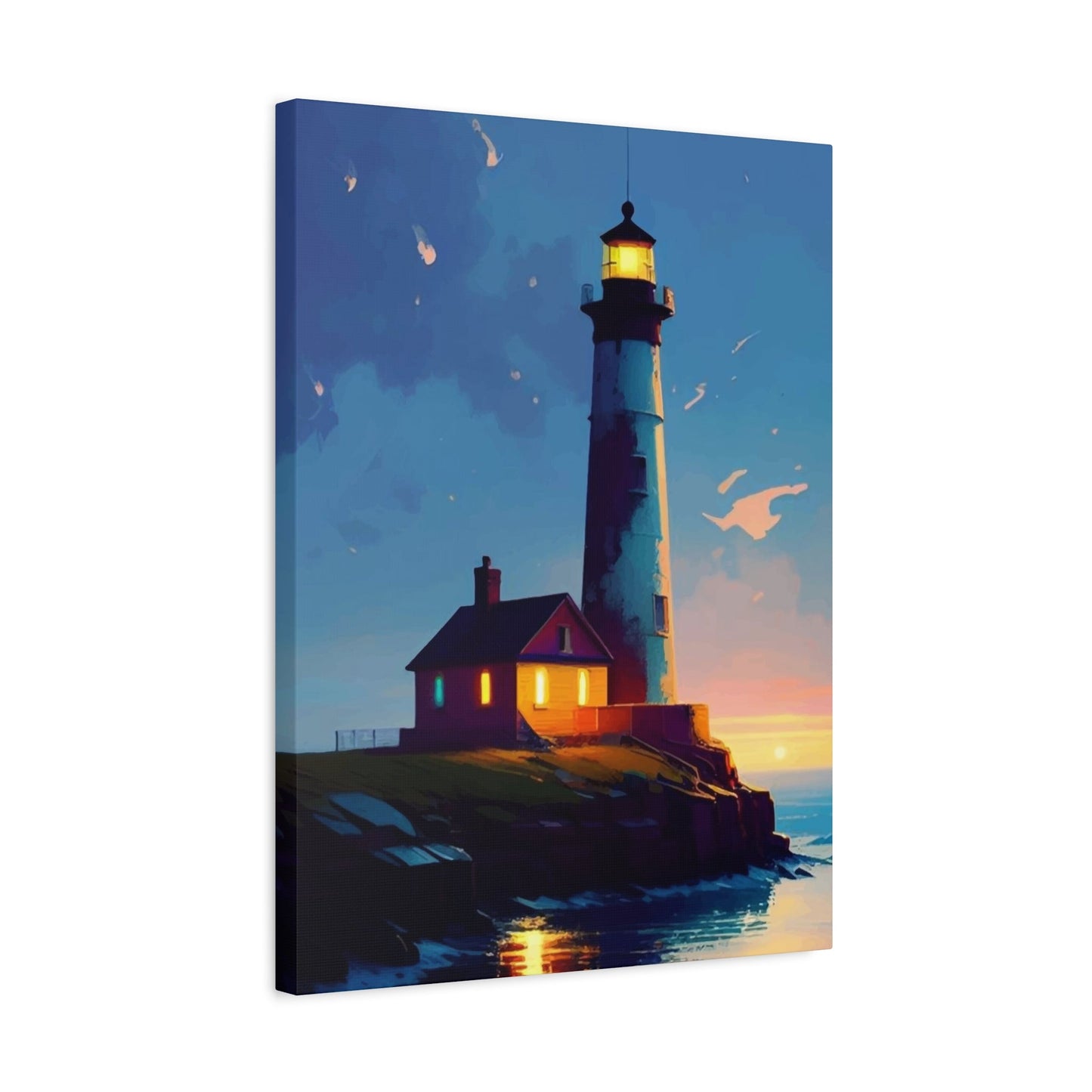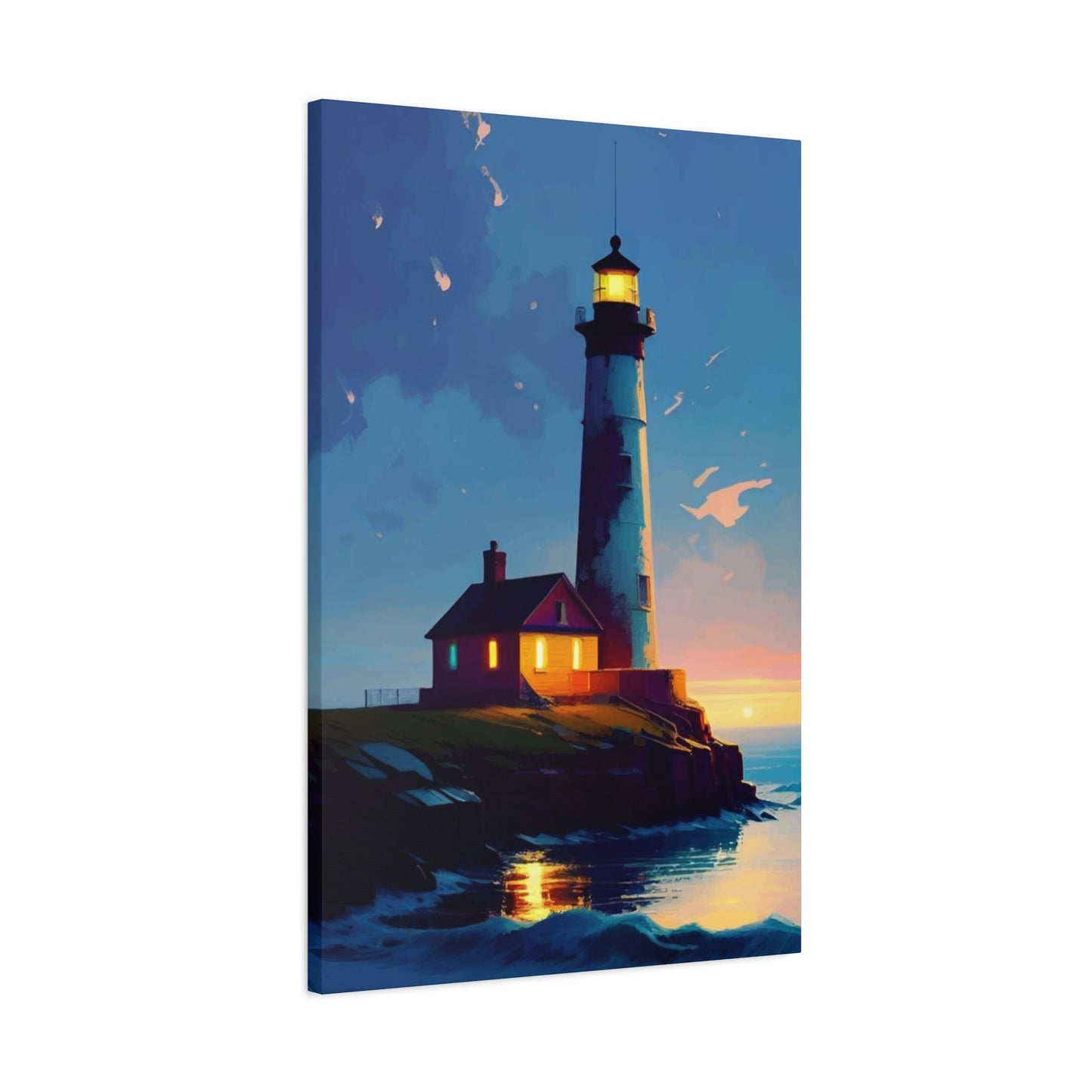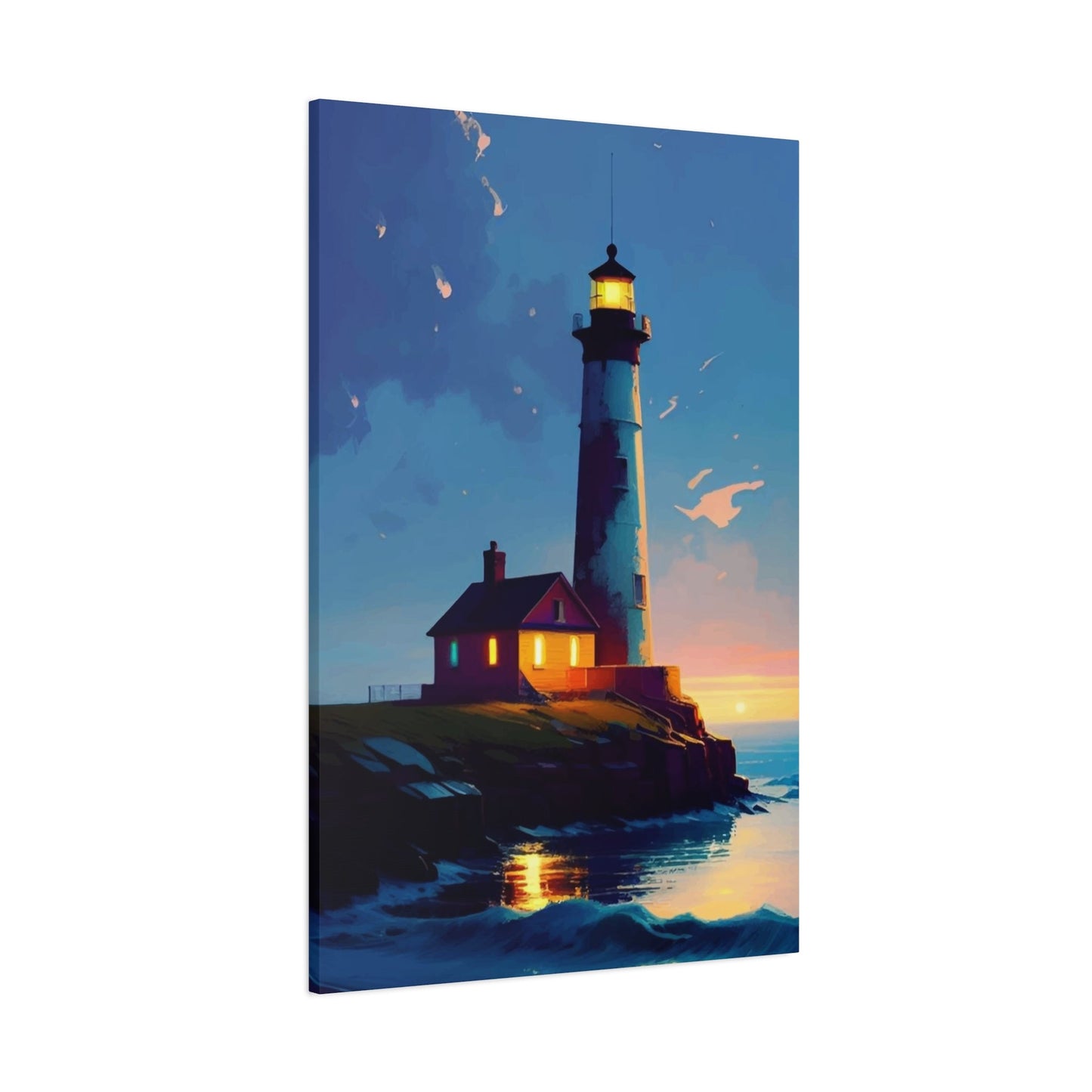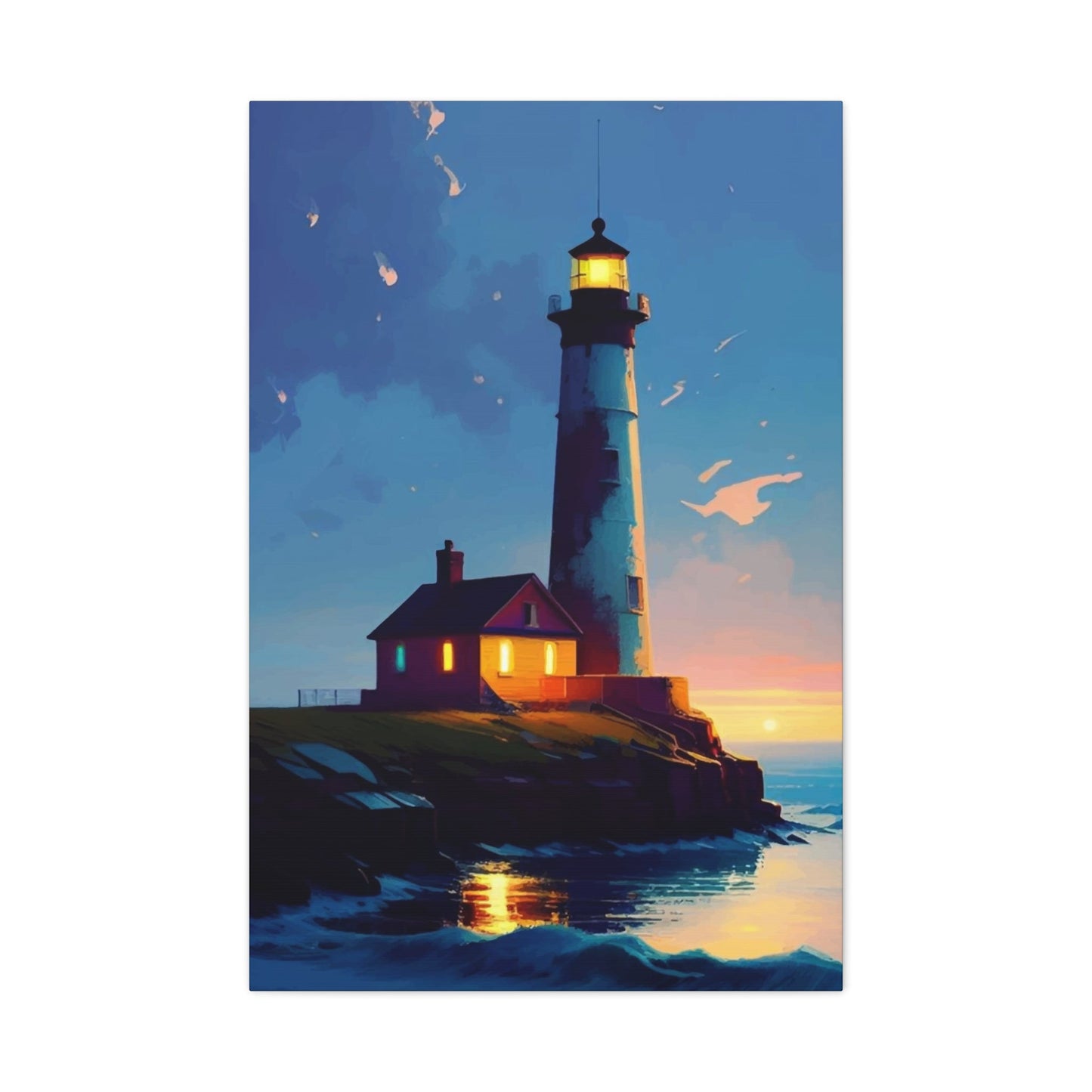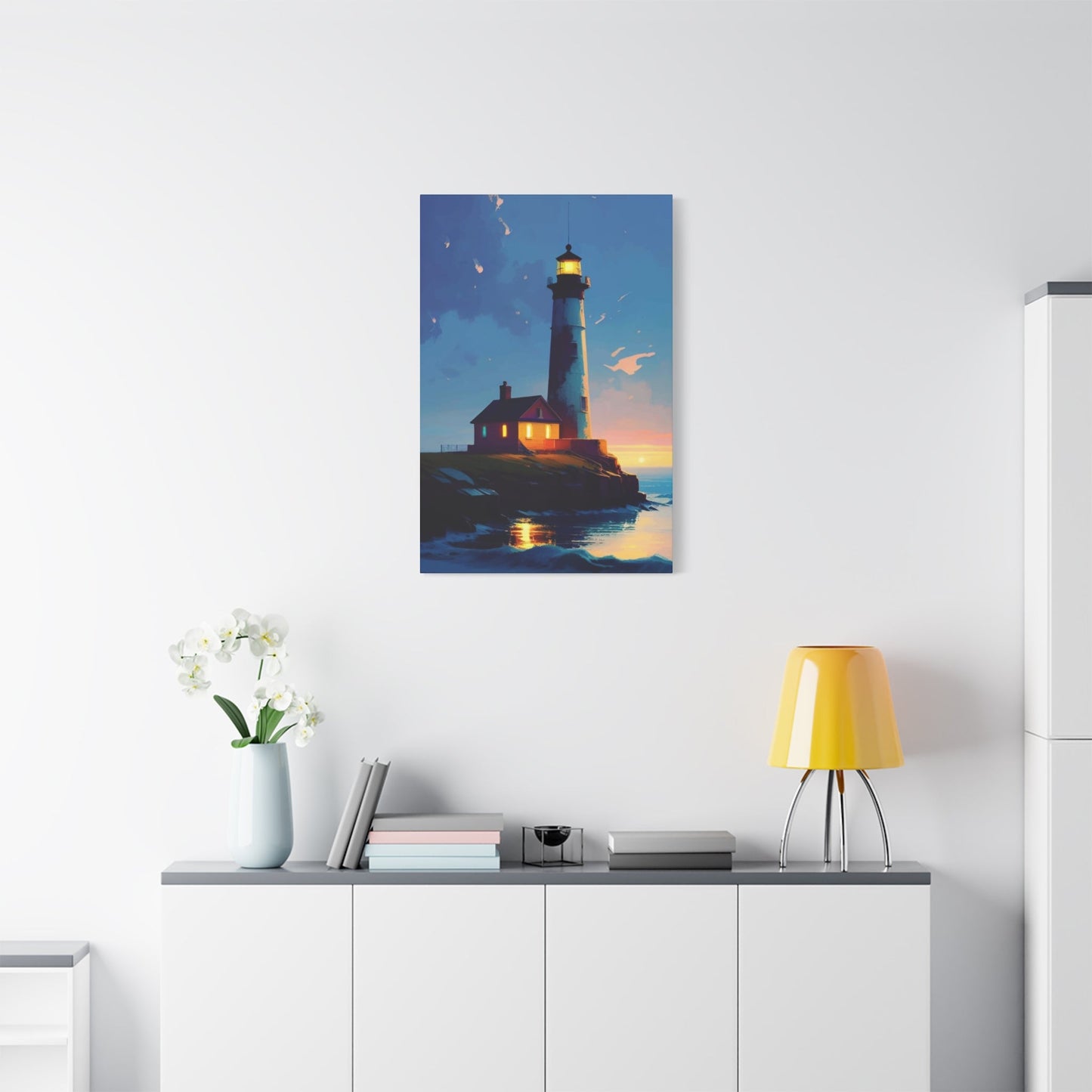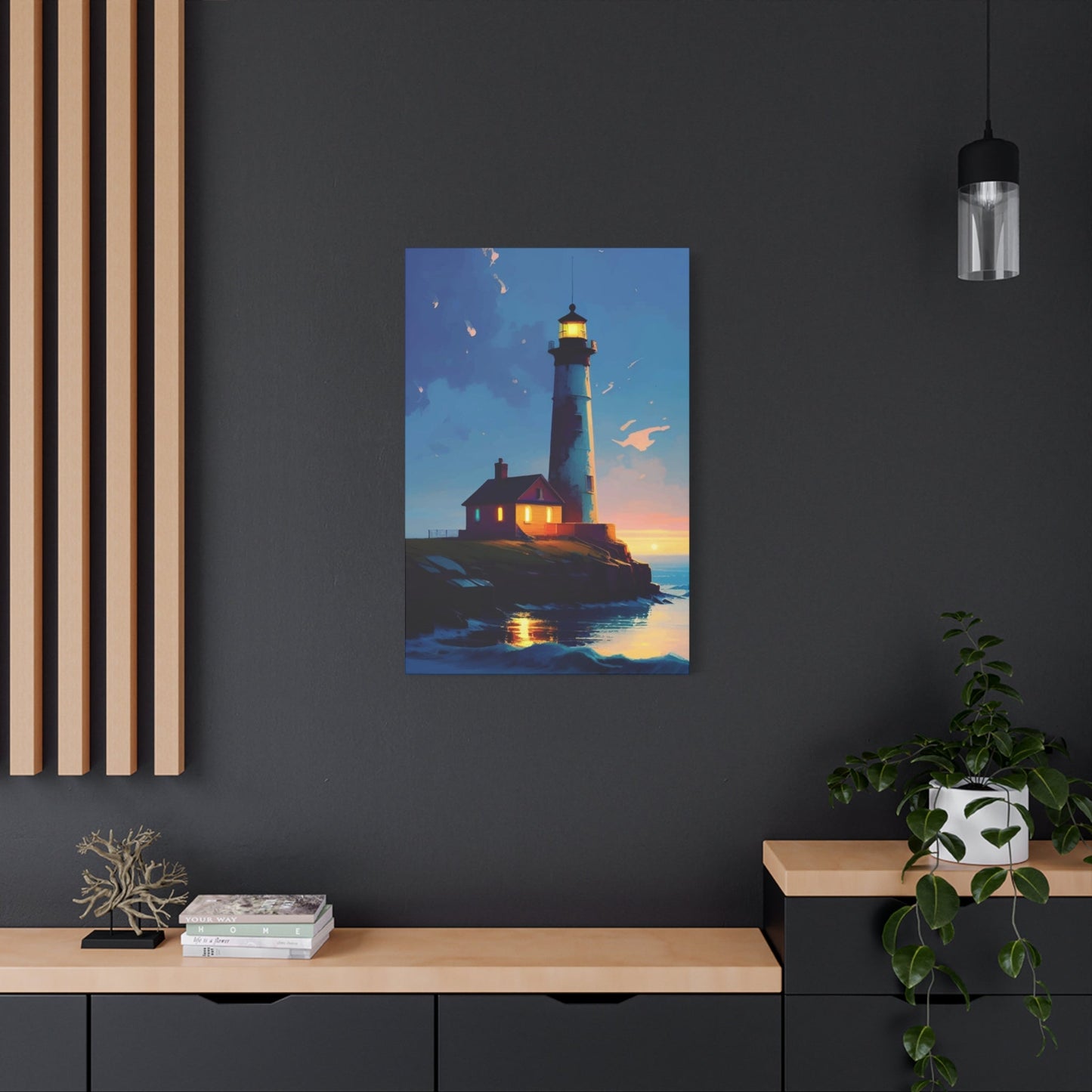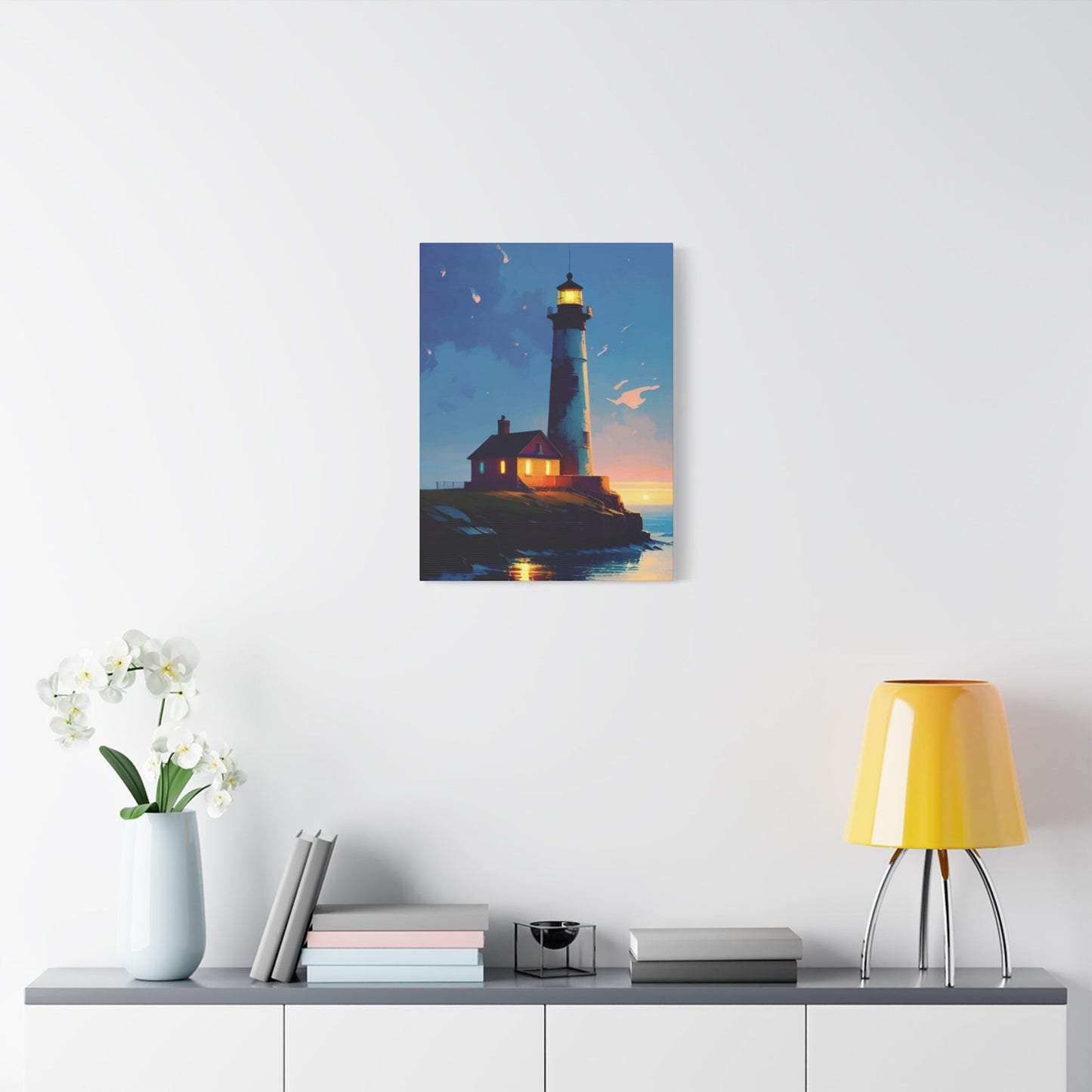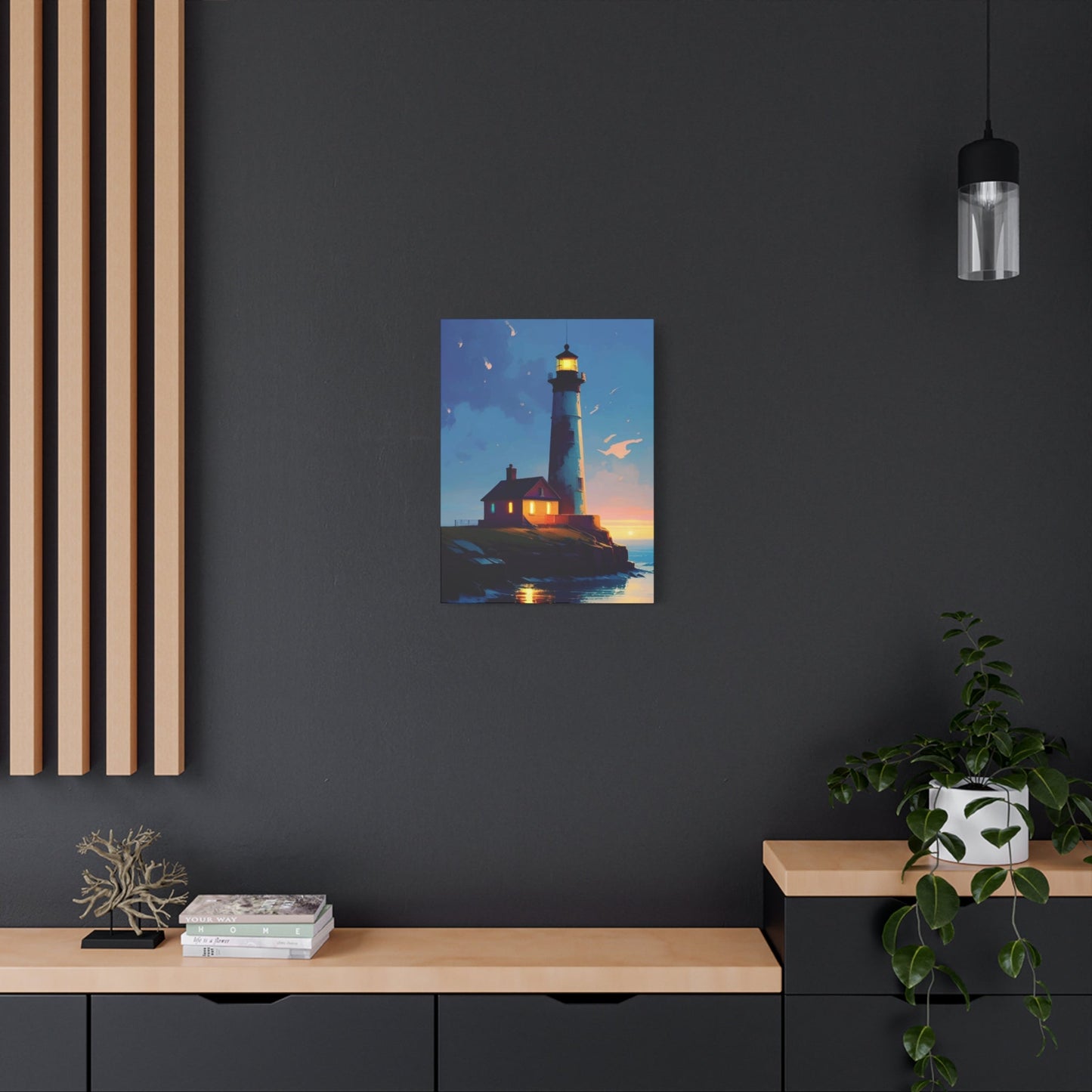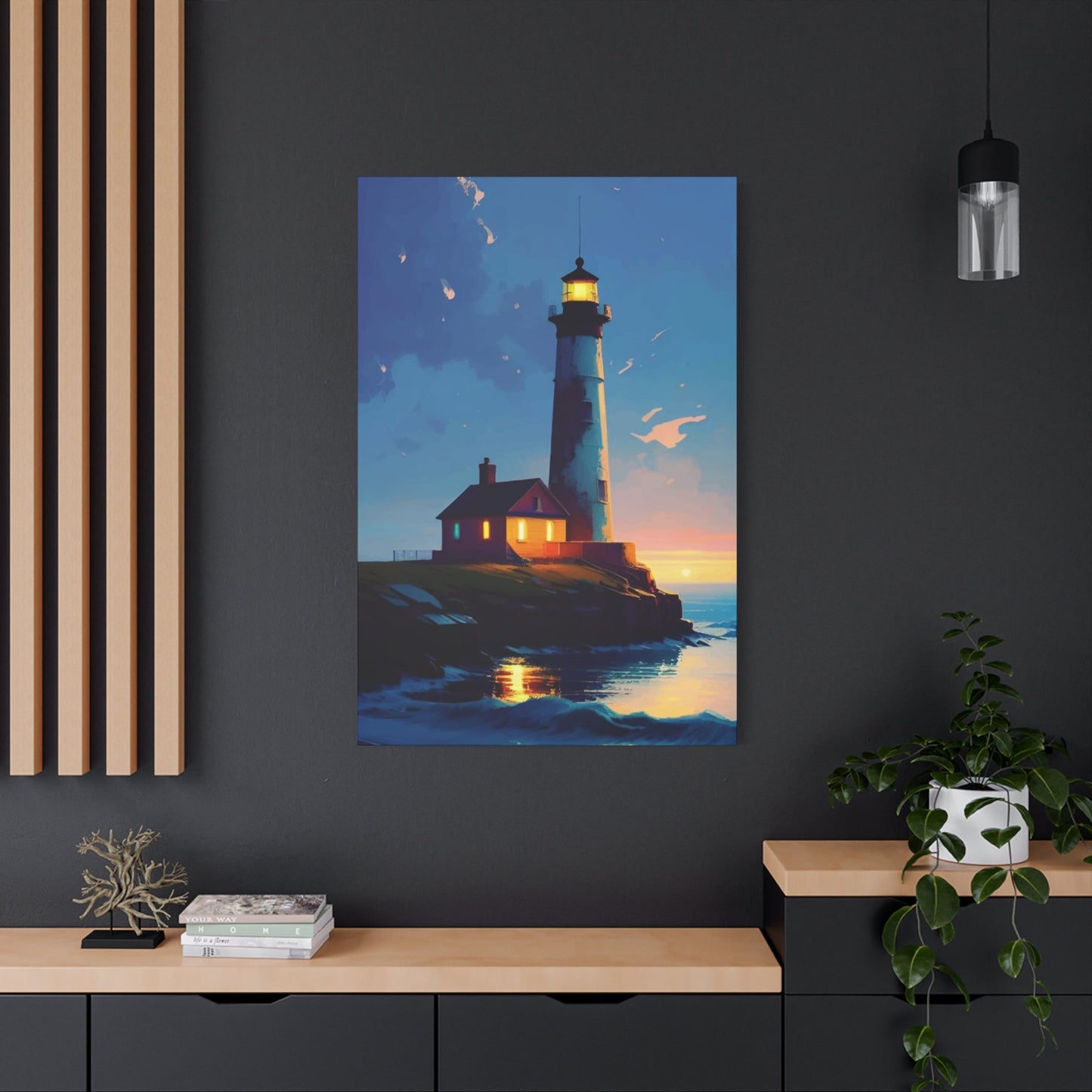A Beacon for Your Home: An In-Depth Exploration of Lighthouse Wall Art
The lighthouse stands as one of humanity's most enduring and powerful symbols. It is a solitary sentinel, a steadfast guardian against the tumultuous power of the sea. For centuries, its rhythmic beam has cut through the darkest storms, offering guidance, hope, and a promise of safe harbor to weary mariners. This potent symbolism transcends its functional purpose, resonating deep within our collective consciousness. It speaks of resilience in the face of adversity, of clarity amidst confusion, and of unwavering strength against overwhelming forces. It is this profound metaphorical weight that makes the lighthouse such a compelling subject for artists and a deeply cherished motif in home decor. Bringing the image of a lighthouse into one's personal environment is more than a decorative choice; it is an intentional act of embedding these very qualities—guidance, safety, and steadfastness—into the atmosphere of a home.
Lighthouse wall art, in its myriad forms, offers a unique opportunity to capture this essence and tailor it to any aesthetic preference. It can be a dramatic focal point that commands attention, a subtle accent that whispers of coastal calm, or a nostalgic piece that evokes tales of adventure and bygone eras. This exploration delves into the vast and varied world of lighthouse wall art, examining how different artistic interpretations, from vintage posters to abstract canvases, can illuminate and enrich our living environments. We will navigate the diverse styles, techniques, and emotional resonances of these captivating artworks, providing a comprehensive view of how a simple beacon can become a profound statement piece on your wall. The journey will reveal that for every personality and every decorative scheme, there is a form of lighthouse wall art waiting to cast its unique and welcoming light.
Vintage Lighthouse Posters for Nautical Decor
The allure of vintage lighthouse posters lies in their remarkable ability to transport us to a different time. They are not merely pictures of lighthouses; they are artifacts of a bygone era, imbued with the nostalgia and romanticism of early twentieth-century travel and graphic design. These posters often originated as advertisements for railway lines, coastal resorts, or steamship companies, designed to entice city dwellers with the promise of fresh sea air, dramatic landscapes, and adventurous holidays. The lighthouses featured in these artworks were depicted as heroic and iconic landmarks, the crown jewels of a rugged and beautiful coastline. The artistic style of this period, characterized by bold lines, simplified forms, and a rich, often limited color palette, lends these pieces a distinct and timeless graphic quality.
They capture the essence of the structure without getting lost in photorealistic detail, focusing instead on the mood and the majestic presence of the beacon against the elements. Incorporating vintage lighthouse posters into a nautical-themed decorative arrangement is a classic choice that adds a layer of historical depth and storytelling. These pieces serve as a window into the past, evoking the spirit of exploration and the golden age of maritime travel. They tell a story not just of the lighthouse itself, but of the culture and aspirations of the time in which they were created. The typography is often as much a part of the artwork as the illustration, with elegant, period-specific fonts that announce the name of the location with a sense of grandeur and importance.
This combination of imagery and text creates a cohesive and evocative piece of art that is both informative and aesthetically pleasing. When selecting vintage lighthouse posters, one might consider the origin and history behind the piece. A poster advertising travel to the coasts of New England will have a different feel from one promoting the Mediterranean shores. This geographical context adds another layer of personality to the artwork, allowing for a more curated and personal collection. The paper on which these posters are reproduced is also a crucial element. A high-quality, matte-finish paper can replicate the look and feel of the original lithographs, enhancing the authentic vintage appeal.
Framing is equally important; a simple, dark wood frame or a distressed white frame can complement the nautical theme beautifully, while protecting the print and giving it a more substantial presence on the wall. Placing these posters in a study, a home office, or a hallway can create a sophisticated and intellectual atmosphere, suggesting a love for history, travel, and the enduring romance of the sea. They pair exceptionally well with other nautical elements like ship models, brass instruments, and antique maps, creating a cohesive and immersive environment. Ultimately, vintage lighthouse posters are more than just decoration; they are conversation starters, pieces of history, and a timeless tribute to the iconic sentinels of the coast. Their enduring appeal lies in their ability to blend art, history, and a sense of adventure into a single, compelling image.
The colors often used in these posters, such as deep navies, creamy whites, signal-flag reds, and weathered yellows, are foundational to the nautical palette, making them easy to integrate into an existing theme. The artists of the time were masters of composition, often using dramatic perspectives to emphasize the height and strength of the lighthouses, silhouetting them against a rising sun or a stormy sky. This inherent drama makes the artwork captivating from across a room. The choice to display a vintage poster can also be a nod to a personal connection, perhaps a lighthouse visited on a memorable trip or one located in a region with family ties. This personal link transforms the artwork from a mere decorative object into a meaningful memento. In a world of fleeting digital images, the tangible, historic quality of a vintage lighthouse poster offers a grounding and enduring charm that continues to captivate and inspire.
Abstract Lighthouse Paintings for Modern Aesthetics
Abstract lighthouse paintings represent a bold departure from literal representation, offering a more emotional and interpretive vision of the coastal beacon. In this artistic realm, the lighthouse is not just a structure of stone and light, but a concept—a convergence of form, color, and emotion. Artists who work in an abstract style deconstruct the familiar image of the lighthouse and reassemble it as an expression of its core symbolism. The rigid, cylindrical form might be suggested by a single, strong vertical brushstroke, while the sweeping beam of light could be a vibrant slash of yellow or white cutting across a tumultuous, textured canvas of blues and grays representing the sea. This approach frees the subject from the constraints of realism and allows for a deeper, more personal connection with the viewer.
The appeal of abstract lighthouse paintings in modern decorative settings is immense. Modern aesthetics often prioritize clean lines, uncluttered compositions, and a focus on color and form over intricate detail. An abstract piece can serve as the perfect focal point in such an environment, injecting a burst of energy, color, and sophisticated intrigue without disrupting the overall minimalist or contemporary feel. It invites contemplation and conversation, as each viewer may see something different in the interplay of shapes and hues. The power of an abstract painting lies in its ability to evoke a feeling rather than simply depict a scene.
A painting with chaotic, dynamic brushwork and a clash of dark and light colors can convey the raw power and danger of a storm, with the lighthouse standing as a fragile yet persistent point of stability. Conversely, an artwork using soft, blended watercolors and a palette of serene blues and sandy beiges can capture the tranquility of a calm dawn, with the lighthouse representing a quiet, watchful presence. The medium itself plays a significant role in the final piece. An artist might use thick, impasto oil paint applied with a palette knife to create a tangible, rugged texture that you can almost feel, mirroring the weathered stone of the lighthouse. Another might choose fluid acrylics, allowing the colors to pour and blend on the canvas, creating an organic and unpredictable representation of water and light.
Mixed media pieces can incorporate elements like sand, fabric, or paper to add further layers of texture and meaning. When incorporating an abstract lighthouse painting into a room, it is essential to consider the scale and color palette. A large-scale abstract canvas can dominate a wall, becoming the undisputed centerpiece of the room. Its colors can then be used as accents throughout the environment, picked up in cushions, throws, or other small decorative objects to create a cohesive and deliberate decorative scheme. A smaller piece might be better suited for a more intimate setting, like a reading nook or a small entryway, where its subtleties can be appreciated up close. Pairing abstract art with simple, modern furnishings allows the artwork to shine. A sleek, unadorned frame, or even a gallery-wrapped canvas with no frame at all, often works best, keeping the focus squarely on the art itself.
The beauty of abstract lighthouse paintings is their versatility and their capacity for personal interpretation. They challenge our perception and encourage us to look beyond the obvious, to feel the essence of the lighthouse—its strength, its solitude, its unwavering purpose—in a way that a purely realistic depiction cannot. This makes them a compelling and sophisticated choice for any modern home seeking to blend artistic expression with profound symbolism.
The dialogue between the artwork and its surrounding environment is crucial. In a room with neutral tones of gray, white, and beige, a vibrant abstract lighthouse painting can act as a powerful punctuation mark, introducing a strategic dose of color that animates the entire setting. Conversely, in a more eclectic room filled with various colors and patterns, a more monochromatic abstract piece, perhaps focusing on the textures of black, white, and gray, can provide a point of visual rest and sophisticated contrast. The emotional resonance of the piece is paramount; it should be an artwork that speaks to the homeowner on a personal level, reflecting their own interpretation of the lighthouse's enduring symbolism.
Serenity and Strength in Lighthouse Canvas Prints
The choice of a canvas print for displaying lighthouse art brings a unique combination of texture, depth, and durability that elevates the image beyond a simple poster or photograph. Canvas, with its woven fabric surface, imparts a painterly quality to any image, lending a sense of artistic gravitas and timelessness. When this medium is used to depict a lighthouse, the result is often an artwork that beautifully balances the dual nature of the subject: its serene, watchful presence and its unyielding strength. The texture of the canvas itself can enhance the visual experience. For an image of a weathered, old lighthouse, the subtle weave of the fabric can mimic the rough-hewn stone or aged brick of the structure, adding a tactile dimension that invites closer inspection.
For a scene featuring a calm sea or a soft, cloudy sky, the matte finish of the canvas diffuses light, preventing glare and creating a soft, almost velvety appearance that enhances the overall feeling of tranquility. One of the most popular styles for lighthouse canvas prints is the gallery wrap. In this presentation, the canvas is stretched around a sturdy wooden frame, with the image continuing over the edges. This creates a clean, contemporary look that requires no external framing, allowing the artwork to float on the wall. This frameless presentation is particularly effective for modern and coastal-themed decors, as it feels uncluttered and allows the image to be the sole focus. The themes of serenity and strength are particularly well-suited to canvas prints. A large canvas print of a lighthouse standing resolute against a dramatic, stormy sky can be incredibly powerful.
The sheer size and the tangible presence of the canvas lend weight and importance to the scene, constantly reminding the viewer of the symbolism of resilience and fortitude. The rich blacks and deep blues of a storm can be rendered with incredible depth on high-quality canvas, while the bright, piercing beam of the lighthouse light appears to cut through the darkness with palpable intensity. Conversely, a canvas print depicting a lighthouse at dawn, bathed in the soft, warm hues of the rising sun with a tranquil sea lapping at its base, can transform a room into a haven of peace and calm. The soft texture of the canvas complements the gentle light, and the image becomes a daily invitation to pause and reflect.
This type of artwork is ideal for bedrooms, living areas, or any environment where a calming influence is desired. The durability of canvas is another significant advantage. Modern printing techniques, such as giclée printing, use archival-quality inks that are resistant to fading, ensuring that the vibrant colors and sharp details of the artwork will last for decades. The canvas is also more robust than paper, less susceptible to damage from humidity or minor bumps. This makes lighthouse canvas prints a practical and long-lasting investment in home decor. When choosing a piece, consider the composition.
A tightly cropped image focusing on the lantern room and the light itself can create a more intimate and detailed portrait of the lighthouse, while a wide-angle shot showing the lighthouse within its broader coastal landscape can evoke a grand sense of scale and place. Whether the goal is to create a statement of bold strength or a sanctuary of quiet serenity, lighthouse canvas prints offer a versatile and sophisticated medium to achieve it. Their unique texture, depth, and modern presentation make them a perfect choice for anyone looking to capture the enduring spirit of the coastal sentinel. The way the ink is absorbed by the canvas fibers also plays a role in the artwork's final appearance.
It creates a richness and saturation of color that is difficult to achieve on paper, making the scenes feel more immersive and vibrant. This is especially true for images with complex color gradients, such as sunsets and sunrises, where the smooth transition of hues is critical to the overall mood. Furthermore, canvas prints are available in a vast range of sizes, from small accent pieces to massive, wall-covering installations. This scalability allows the homeowner to perfectly match the artwork to the proportions of their room, ensuring that the piece feels integrated and intentional. A triptych, where a single image is split across three separate canvas panels, can be a particularly dynamic and contemporary way to display a panoramic lighthouse scene, adding architectural interest to a large, blank wall.
Black and White Lighthouse Photography Art
There is a timeless, dramatic, and profoundly evocative quality to black and white photography that lends itself perfectly to the subject of lighthouses. By stripping away the color, the photographer forces the viewer to engage with the fundamental elements of the scene: form, texture, light, and shadow. In the context of a lighthouse, this monochromatic approach accentuates its architectural lines, its rugged texture, and its symbolic role as a solitary beacon in a world of grays. Black and white lighthouse photography art is a choice for those who appreciate classic aesthetics and powerful, emotive imagery. The absence of color removes distractions and allows the core narrative of the image to come to the forefront.
The stark, cylindrical form of the lighthouse becomes a powerful geometric statement against the organic chaos of the sea and sky. The contrast between the brilliant white of the tower, illuminated by the sun, and the deep, inky blacks of the shadows it casts or the storm clouds gathering behind it, creates a visual tension that is both dramatic and beautiful. The textures in the image are also amplified. Every crack in the stone, every rust stain on the metalwork, and every ripple on the surface of the water becomes more pronounced and significant. An artist might use a long exposure technique to smooth the tumultuous sea into a misty, ethereal blanket, making the solid, sharply focused lighthouse appear to rise from a dreamscape.
This technique emphasizes the steadfast, unchanging nature of the lighthouse against the fluid, ever-moving world around it. Conversely, a fast shutter speed can freeze the explosive power of a wave crashing against the base of the tower, capturing a moment of intense conflict between man-made structure and natural force. The mood created by black and white lighthouse photography can range from melancholic and contemplative to awe-inspiring and heroic. An image of a lighthouse shrouded in fog, its form barely visible, can evoke feelings of mystery, solitude, and introspection. An image of the same lighthouse standing tall under a clear, star-filled night sky can inspire a sense of wonder and the sublime.
This emotional range makes black and white photography a versatile choice for various home environments. In a minimalist or industrial-themed room, a large, framed black and white lighthouse photograph can serve as a stunning and sophisticated focal point. Its clean, graphic quality complements the uncluttered aesthetic, while its inherent drama adds a layer of emotional depth. Simple framing, such as a thin black or silver metal frame with a wide white mat, can enhance the artwork's impact by creating a visual separation from the wall and drawing the eye inward to the photograph itself. For a more traditional or rustic setting, a black and white print in a weathered wood frame can add a sense of history and nostalgia.
It can feel like a historical document, a window into a moment frozen in time. Pairing such a piece with leather furniture, dark woods, and antique objects can create a warm, library-like atmosphere. Selecting a piece of black and white lighthouse photography is about choosing an image that resonates on an emotional level. It is about appreciating the artistry in the composition, the masterful use of light and contrast, and the powerful story the image tells without a single word or color. It is a tribute to the raw, elemental beauty of the coast and a celebration of the enduring strength of the structures that guard it.
This form of art is not merely decorative; it is a piece of fine art that adds a sense of gravitas and sophistication to any collection. The interplay of light is perhaps the most critical element. The beam from the lantern room, rendered in pure white against a black night, becomes the undeniable hero of the image, a singular point of hope and clarity. The way sunlight rakes across the surface of the tower at dawn or dusk, revealing its texture and form, can be breathtakingly beautiful in monochrome. Photographers specializing in this genre are masters of tone and contrast, using dodging and burning techniques in the darkroom or their digital equivalent to guide the viewer's eye and emphasize the emotional core of the scene.
Colorful Sunset Lighthouse Wall Murals
A colorful sunset lighthouse wall mural is not just a piece of art; it is an immersive experience that can fundamentally transform the atmosphere of an entire room. By dedicating an entire wall to a single, expansive image, a mural creates a powerful sense of depth and presence, effectively removing the boundary of the wall and opening the room up to a breathtaking coastal vista. The combination of a lighthouse, a potent symbol of hope and guidance, with the daily spectacle of a sunset, a moment of profound beauty and transition, creates an emotionally rich and visually stunning composition. The psychological impact of a sunset mural is significant. The warm, vibrant colors typically associated with sunsets—fiery oranges, deep reds, soft pinks, and rich purples—are known to evoke feelings of warmth, happiness, and optimism. They can make a room feel cozier and more inviting.
This daily celestial event marks the peaceful conclusion of the day and holds a promise of a new beginning with the dawn to come. Placing this imagery in a living area, bedroom, or dining room can infuse the environment with a sense of calm, wonder, and positivity. The lighthouse within this scene adds another layer of meaning. As the natural light of the sun fades, the man-made light of the beacon begins its nightly vigil. The mural captures this pivotal moment of transition, highlighting the lighthouse's unwavering purpose. It stands silhouetted against the glorious colors of the dying day, a steadfast guardian ready for the darkness. This narrative of duty and resilience, set against a backdrop of natural splendor, is both inspiring and deeply comforting. From a decorative standpoint, a lighthouse sunset mural becomes the undeniable focal point of the room.
All other decorative elements should be chosen to complement, rather than compete with, its powerful presence. Furniture can be arranged to face the mural, creating a viewing area that feels like a window looking out onto the ocean. The color palette for the rest of the room can be drawn directly from the hues within the mural. For instance, soft pinks or corals from the clouds could be used for accent cushions, while the deep blues of the sea could inform the color of a rug or a sofa. This creates a harmonious and professionally curated feel. The technology behind modern wall murals has made them more accessible and higher quality than ever before. High-resolution photography and advanced printing techniques ensure that the image is sharp, vibrant, and detailed, even at a large scale.
Rustic and Weathered Lighthouse Art Pieces
Rustic and weathered lighthouse art pieces celebrate the beauty of imperfection, the passage of time, and the relentless power of the natural elements. This style is not concerned with pristine, postcard-perfect depictions of lighthouses. Instead, it focuses on their character, earned through decades, or even centuries, of standing against wind, rain, and salty sea spray. These artworks evoke a sense of history, endurance, and a deep connection to the raw, untamed coastline. The materials used are central to the rustic aesthetic. Artists often work with reclaimed wood, driftwood, and corroded metals to create their pieces. A lighthouse painted on a canvas of weathered barn wood, for instance, immediately has a history and texture that a standard canvas cannot replicate.
The grain of the wood, its knots, and its imperfections become part of the artwork itself, suggesting the aged and sturdy nature of the lighthouse. Similarly, a sculpture of a lighthouse crafted from pieces of driftwood found on a beach has a direct, physical link to the coastal environment it represents. The artistic techniques employed in this style often involve distressing, where new materials are made to look old. Paint might be applied in layers and then sanded back to reveal the colors underneath, mimicking the way paint peels and fades over time. A whitewash or a crackle finish can be used to give a piece an aged patina. Metal components might be intentionally rusted or treated to create a verdigris effect, suggesting the corrosive impact of the salt-laden air.
The color palette for rustic lighthouse art is typically muted and earthy, drawn from the natural world. Think of the soft grays of weathered stone, the deep browns of old wood, the chalky whites of peeling paint, and the subtle blues and greens of the sea and sky on an overcast day. These understated colors create a calming, grounding effect and allow the texture and form of the artwork to take center stage. Incorporating rustic and weathered lighthouse art into home decor is a way to add warmth, character, and a touch of nostalgia. This style is a natural fit for decorative schemes like coastal cottage, modern farmhouse, shabby chic, and even industrial lofts. A large, distressed wooden sign featuring a painted lighthouse can be a wonderful focal point above a fireplace or in an entryway.
A collection of smaller, hand-carved lighthouse figures displayed on a mantle or a bookshelf can add a charming, handcrafted touch. These pieces tell a story. They suggest a history, real or imagined, of storms weathered and ships guided safely to shore. They feel authentic and grounded, a welcome contrast to the mass-produced, polished items that can sometimes dominate modern decor. They serve as a reminder that there is beauty in aging, in resilience, and in the marks left by a life of purpose. When choosing a rustic lighthouse art piece, look for signs of genuine craftsmanship and attention to detail. The distressing should feel natural, not forced. The materials should have character. The overall piece should evoke a sense of place and history.ative objects, but artifacts that enrich the narrative fabric of a home.
Minimalist Lighthouse Line Art for Clean Decor
Minimalist lighthouse line art is the epitome of the "less is more" philosophy. In this style, the artist strips the subject down to its most essential elements, capturing the iconic form of the lighthouse with a single, continuous line or a few carefully placed strokes. The result is a piece of art that is elegant, sophisticated, and incredibly impactful in its simplicity. The focus is not on detailed representation but on the purity of the form and the negative expanse that surrounds it. This artistic approach celebrates the power of suggestion. The viewer's brain is invited to fill in the missing details, making the act of looking at the art a more engaging and personal experience. A simple black line on a white background can perfectly convey the silhouette of a lighthouse against the sky, its sturdy base, its tapering tower, and the lantern room at its peak.
The beam of light might be represented by a few radiating lines or left entirely to the imagination. The beauty of this style lies in its ability to communicate a powerful symbol with the utmost economy of means. Minimalist line art is perfectly suited for clean, contemporary, and Scandinavian-inspired decorative schemes. These styles prioritize uncluttered settings, natural light, and a neutral color palette. A piece of minimalist lighthouse art complements this aesthetic perfectly. It adds a point of artistic interest and symbolic meaning without introducing visual noise or clutter. Its graphic nature feels modern and intentional, and its understated elegance prevents it from overwhelming the serene atmosphere of the room.
Placement is key to maximizing the impact of minimalist art. A small, framed piece of line art can be a perfect addition to a gallery wall, providing a moment of visual calm among more complex or colorful pieces. A larger piece can stand on its own, creating a sophisticated and contemplative focal point in a living room, bedroom, or home office. The simplicity of the art allows it to be framed in a variety of ways. A thin black or natural wood frame enhances the minimalist feel, while a more ornate frame could be used to create an interesting juxtaposition between the simple art and a more traditional setting. The color palette of minimalist line art is typically monochromatic—black on white or white on black.
However, some artists introduce a single, deliberate pop of color. For example, the entire lighthouse might be drawn in black, with just a small dot of yellow or red to represent the light. This small detail can be incredibly effective, drawing the eye and adding a layer of symbolic emphasis to the beacon's function. This style of art is not just about what is drawn, but also about what is left out. The empty expanse around the lines is an integral part of the composition. This "negative expanse" gives the artwork room to breathe and allows the central image to stand out with greater clarity and force. It creates a sense of openness and calm, which is highly desirable in a relaxing home environment.
Choosing minimalist lighthouse line art is a statement of refined taste. It shows an appreciation for subtlety, for the power of simple forms, and for art that engages the mind rather than just overwhelming the senses. It is a modern, intelligent, and deeply symbolic way to incorporate the timeless image of the lighthouse into a contemporary home, proving that a single line can indeed speak volumes about strength, guidance, and clarity. The intellectual appeal of this style cannot be overstated. It aligns with principles of modern design theory, where form follows function, and every element has a purpose. The line itself becomes a subject of appreciation for its quality—its smoothness, its weight, and its confident execution.
Ocean-Inspired Lighthouse Art for Beach Homes
For a beach house, the inclusion of lighthouse art feels less like a thematic choice and more like a natural extension of the surrounding environment. Ocean-inspired lighthouse art for beach homes is designed to harmonize with the light, airy, and relaxed atmosphere of a coastal setting. This style is all about capturing the specific light, colors, and textures of the seaside and celebrating the lighthouse as an integral and beloved part of that landscape. The color palette is paramount in this genre. The artworks are often dominated by the colors found right outside the window: the myriad blues and greens of the ocean, from pale turquoise to deep navy; the soft, sandy tones of the shore; the brilliant white of seafoam and clouds; and the sun-bleached hues of driftwood and seagrass.
These colors create an immediate sense of cohesion between the indoor environment and the outdoor view, reinforcing the feeling of being at the coast. The art is designed to complement, not overpower, the natural beauty of the location. The depiction of the lighthouse itself is often softer and more romanticized than in other styles. The artwork might show the lighthouse on a bright, sunny day, with a clear blue sky and gentle waves lapping at its base. It might incorporate other elements of beach life, such as shorebirds soaring overhead, sailboats gliding by on the horizon, or sand dunes dotted with waving grasses in the foreground.
The goal is to create a scene that is idyllic and peaceful, evoking the feeling of a perfect day at the beach. Various media can be used to achieve this effect. Watercolor paintings are a particularly popular choice. The translucent, fluid nature of watercolors is perfect for capturing the shimmering quality of light on water and the soft, hazy atmosphere of a humid coastal day. The colors can be layered to create depth while maintaining a feeling of lightness and spontaneity. Acrylic paintings on canvas are also common, allowing for more vibrant, opaque colors and textured brushwork that can depict the froth of waves or the rough surface of the dunes.
Photography in this style tends to be bright and high-key, with an emphasis on natural light and vibrant, saturated colors. A photograph of a classic white lighthouse against a brilliant blue sky is a quintessential piece of beach house art. It is cheerful, clean, and unambiguously coastal. These pieces are often framed in simple, casual materials that reflect the beach aesthetic. A whitewashed or distressed wood frame is a classic choice, as is a simple frame made of light-colored natural wood like pine or ash. A gallery-wrapped canvas with no frame at all also works well, contributing to the relaxed and unfussy vibe. Ocean-inspired lighthouse art is perfect for any room in a beach house, from the main living area to the bedrooms and bathrooms. It reinforces the home's identity and connection to its location.
A large statement piece can set the tone for the entire home, while a collection of smaller pieces can be used to create a charming coastal gallery wall. More than just a picture, this type of art is a celebration of a lifestyle—one that is connected to the rhythm of the tides, the warmth of the sun, and the enduring, reassuring presence of the coastal beacon. It helps to bring the beauty and tranquility of the ocean indoors, ensuring that the peaceful beach atmosphere can be enjoyed no matter the weather outside. The context of the artwork is everything; it should feel as if it truly belongs in that setting, reflecting the specific character and charm of that particular stretch of coastline.
DIY Lighthouse Wall Art Projects
Creating your own DIY lighthouse wall art is a deeply rewarding experience that allows you to infuse your personal touch and creativity directly into your home decor. A do-it-yourself project transforms you from a passive consumer of art into an active creator, resulting in a one-of-a-kind piece that is imbued with personal meaning and the pride of accomplishment. The subject of the lighthouse is wonderfully adaptable to a wide range of DIY techniques, from simple projects for beginners to more complex creations for experienced crafters. One of the most accessible DIY lighthouse projects involves using stencils. You can purchase or create a stencil of a lighthouse silhouette and use it to paint the image onto a variety of surfaces.
A piece of reclaimed wood or a set of old pallet boards can serve as a rustic and textured canvas. By painting the boards first with a base color, perhaps a sea blue or a sandy beige, and then stenciling the lighthouse in a contrasting color like white or charcoal gray, you can create a charming, farmhouse-style art piece. You can further distress the wood with sandpaper to enhance the weathered, coastal feel. Another popular DIY approach is string art. This involves hammering small nails into a wooden board to create the outline of a lighthouse and its light beams. Then, you weave colored string or embroidery floss back and forth between the nails to fill in the shape.
This technique creates a fascinating, three-dimensional piece with a unique texture. You can use classic white string for the tower and a vibrant yellow or orange for the light, creating a striking and graphic representation of the beacon. For those who enjoy working with natural materials, a driftwood or pebble art project is a perfect choice. By collecting smooth, flat pebbles of various sizes and shades of gray and white from the beach, you can arrange and glue them onto a sturdy backing (like a piece of wood or a canvas board) to construct a mosaic-style image of a lighthouse. Small pieces of colored sea glass can be used for the light.
A sculpture created from pieces of driftwood, carefully selected and joined together to form the shape of a lighthouse, can be a stunning and organic piece of art that brings the raw, natural beauty of the coast indoors. Painting your own lighthouse is another wonderful option, and you don't need to be a professional artist to achieve a beautiful result. A simple, folk-art style painting on a small canvas can be just as charming as a photorealistic masterpiece. You can follow online tutorials or simply let your imagination guide you. The goal is not perfection, but personal expression. Using acrylic paints, you can create a vibrant and cheerful scene or a more moody and atmospheric one.
Don't be afraid to experiment with color and texture. A collage is another fantastic DIY avenue. You can create a lighthouse image by cutting and pasting pieces from old maps, nautical charts, book pages, or magazines. This mixed-media approach can result in a rich, layered piece that is full of interesting details and hidden meanings. The key to a successful DIY lighthouse wall art project is to choose a technique that you enjoy and to embrace the creative process. The final product will be more than just a decoration; it will be a story of your time, your effort, and your personal connection to the enduring symbol of the lighthouse. It’s a piece that will not only enhance your decor but will also serve as a constant reminder of your own creativity.
Conclusion
The lighthouse, in its solitary vigil, has always been more than a mere navigational aid. It is a profound and multi-faceted symbol that speaks to the deepest parts of the human experience. It is a monument to resilience, an icon of guidance, a promise of safety, and a beacon of hope in the literal and metaphorical storms of life. This rich tapestry of meaning is precisely what makes lighthouse wall art such a powerful and enduring choice for the home. As we have explored, the interpretation of this single, powerful subject is nearly limitless, offering a style and an emotional resonance to suit every individual taste and decorative sensibility. From the nostalgic charm of vintage travel posters that transport us to a golden age of adventure, to the emotive power of abstract paintings that capture the feeling rather than the form of the beacon, the lighthouse proves to be an endlessly versatile artistic muse.
The journey through these varied artistic expressions reveals a fundamental truth: the way we choose to decorate our personal environments is a reflection of the values we hold and the atmosphere we wish to cultivate. Choosing a dramatic, high-contrast black and white photograph of a lighthouse battered by waves is an affirmation of strength and the beauty of perseverance. Opting for a serene and colorful canvas print of a lighthouse at dawn is an invitation for peace and contemplation to enter the home. Creating an immersive, wall-sized mural of a sunset over a coastal beacon is a bold declaration of optimism and a commitment to living within beauty. A rustic, weathered piece crafted from reclaimed wood speaks to a love of history, authenticity, and the character earned through endurance, while a minimalist line drawing celebrates the elegance of simplicity and the power of pure form.
The personal act of creating a DIY lighthouse art piece further deepens this connection, weaving the creator's own story and effort into the very fabric of the artwork. Each style, whether purchased from a gallery or crafted on a kitchen table, offers a unique lens through which to view and appreciate the lighthouse's symbolism. This extensive exploration demonstrates that lighthouse wall art is not a monolithic category. It is a rich and diverse world of artistic possibility. It can be grand and heroic, quiet and contemplative, modern and graphic, or rustic and charming. Ultimately, selecting a piece of lighthouse wall art is a deeply personal choice. It is about finding the specific interpretation that resonates with your own story, your own aesthetic, and the particular feeling you want your home to evoke.













